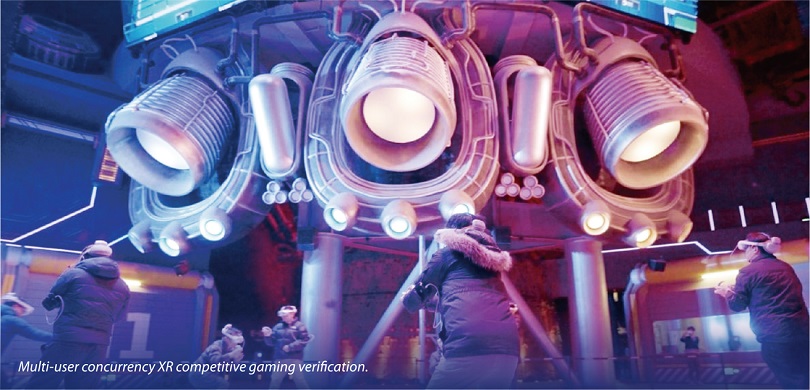5G-A Minimalist Private Network: Unleashing Free-Roam VR
Free-roam VR, or location-based entertainment (LBE) VR, offers an immersive experience by creating virtual environments in large physical spaces where users can move and interact with dynamically changing virtual content. The LBE VR market has witnessed remarkable growth in recent years, with a projected compound annual growth rate (CAGR) of 28.3% from 2023 to 2030.
Free-Roam VR’s Rapid Growth in China
As one of the world’s leading metaverse markets, China is entering a rapid growth phase in the LBE VR sector. At present, more than 100 LBE VR projects based on popular intellectual properties (IPs) have been launched in the country, with 41% of these projects focused on the Chinese culture. Industry data indicates that the LBE VR market in China is expected to exceed 250 billion yuan by 2026, positioning LBE VR a landmark industry in the new-quality productivity sector.
The popularity of LBE VR can be attributed to its ability to combine exceptional narrative capabilities with well-known IPs. These LBE VR projects reduce the sense of unfamiliarity often associated with VR but also provide enhanced interactive experiences. The overall user experience is at the heart of VR market recognition. For example, the precision of graphics impacts user immersion, while narrative and interactivity determine user engagement and emotional connection.
Bottlenecks in LBE VR Development
While LBE VR is rapidly gaining market recognition, it still faces huge challenges in scaling and inconsistent technical standards, which affect content quality, user experience, and long-term profitability of VR providers. Currently, mainstream technical solutions present several shortcomings:
- Backpack rendering solution: Users must wear a heavy 5 kg backpack with a rendering laptop, which is tough for adults to endure 45-60 minutes, let alone for children and the elderly. Moreover, traditional backpacks face issues such as poor heat dissipation, short battery life, and high costs.
- VR headset rendering solution: Due to the limited computing power of VR headsets, graphic quality is seriously degraded, and positional tracking becomes inaccurate, failing to deliver an immersive experience.
- Wi-Fi-based edge rendering solution: Wi-Fi’s limited bandwidth and spectrum interference restrict the number of simultaneous players, reducing video and graphic quality as player numbers increase, ultimately impacting revenue and user satisfaction.
Therefore, it is crucial to develop a solution that enhances the user experience by providing high-quality graphics while ensuring high operational efficiency for businesses.
ZTE’s 5G-A Minimalist Private Network Leads Next-Generation LBE VR
ZTE’s innovative 5G-A minimalist private network addresses these challenges by offering an all-in-one large-capacity and low-latency 5G-A network without requiring a core network. The solution combines edge computing with the powerful capabilities of 5G-A networks, creating a tailor-made, high-performance network for LBE VR applications.
Self-Sustained Deployment
Its deployment is self-sustained, requiring nothing from mobile operators other than spectrum. This makes it perfect for densely populated business areas where both people traffic and data traffic are off the charts, leaving little room for mobile operator to squeeze strained resources.
Streamlined, Secure, and Fast Network
All data remains on-site and is fully controlled by VR providers. The 5G-A base station, or more precisely, the baseband unit, do the “light-lifting” by the otherwise needed core network. This ensures not only data security but also extremely fast data processing.
mmWave to Support More Users
ZTE's MiCell, the industry's first millimeter wave (mmWave) distributed micro-cell and IF pooling solution, supports 800 MHz bandwidth and can achieve a peak data rate of 6 Gbps per single cell. Combined with the powerful computing board NodeEngine and SuperMicell’s intelligent beam management solution, it enhances service coverage, meets the mobility needs of XR applications, and ensures the certainty of a large amount of concurrent XR data.
XR-Specific Solution Providing Deterministic Guarantees
Designed specifically for VR, this solution ensures end-to-end reliability for high-priority VR services. By optimizing resource scheduling based on real-time user experience and network conditions, it prioritizes either bandwidth efficiency or video quality, offering a future-proof solution tailored for the evolving needs of VR.

In 2024, ZTE teamed up with China Mobile, Qualcomm and Sky Limit Entertainment to complete the industry’s first 5G-A multi-user concurrency XR competitive gaming services at Sky Limit Entertainment’s SoReal Paradise in Shougang Park, Beijing. ZTE deployed the MiCell to provide high-capacity, low-latency network coverage. Clear pictures in gaming reached a high picture quality of 4K @90 fps, a mainstream level in the industry. The 5G-A XR-specific solution ensures XR services’ performance with slot-level intelligent scheduling and optimization policy, achieving an average air interface latency of less than 15 ms. This verification demonstrated that this end-to-end solution delivers a wireless XR experience in a large space and can support more than 50 users enjoying XR gaming simultaneously. This innovation has won multiple industry accolades.
Looking ahead, ZTE will continue to work closely with strategic partners constantly enrich 5G-A solutions, drive the XR industry to thrive, and expand scenario-based application rollouts across industries.